| Part of a series on the |
| Culture of New Zealand |
|---|
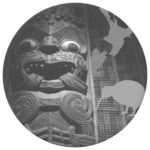 |
National symbols of New Zealand are used to represent what is unique about the nation, reflecting different aspects of its cultural life and history.
| Part of a series on the |
| Culture of New Zealand |
|---|
 |
National symbols of New Zealand are used to represent what is unique about the nation, reflecting different aspects of its cultural life and history.
| Symbol | Image | Adopted | Remarks | |
|---|---|---|---|---|
| Flag | Flag of New Zealand |  | 24 March 1902 [1] | A Blue Ensign with the Southern Cross of four white-edged red five-pointed stars centered on the outer half of the flag. [2] |
| Coat of arms | Coat of arms of New Zealand | 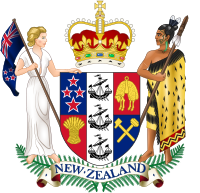 | Adopted in 1911 and revised in 1956 [3] | The symbols on the shield represent the country's maritime trade, agriculture and industry. A European woman and a Māori chief flank the left and right sides, identifying New Zealand as a bicultural nation (European New Zealanders and Māori). The figures are supported by the silver fern, a native plant. The St Edward's Crown is a reminder that New Zealand is a constitutional monarchy. [4] |
| National anthems | "God Defend New Zealand" and "God Save the King" | "God Defend New Zealand" "God Save the King" | "God Defend New Zealand" was adopted in 1977. [5] | Both are official, though in most circumstances "God Defend New Zealand" is used as the anthem. "God Save the King" is generally used only on regal and viceregal occasions. [5] |
| National colours | The national colours of New Zealand orders are black, white or silver, and red ochre. |  | New Zealand Orders have used these colours since 1975. [6] | The national Māori flag also uses these colours, with attached symbolism. [7] Red ochre (kokowai) has a spiritual significance in Māori culture, associated with life and vitality. [6] [8] |
| Symbol | Image | Remarks | |
|---|---|---|---|
| National bird | Kiwi (Apteryx mantelli) |  | The term Kiwis has been used as a nickname for New Zealanders since at least World War I, and the bird's use as a symbol for the country dates from the same era. [9] |
| National plant | Silver fern (Cyathea dealbata) |  | A species of medium-sized tree fern, endemic to New Zealand. Often referred to by its Māori name, ponga, the silver fern has been used to represent New Zealand since the 1880s. [10] |
| National flower | Kōwhai (Sophora tetraptera) | 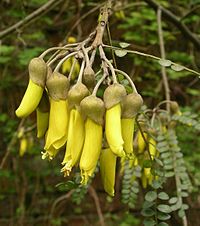 | Evergreen tree, producing bright yellow flowers in spring. Blooms of kōwhai are found throughout New Zealand in a diverse range of habitats. [11] The Department of Conservation notes that kōwhai is widely regarded as being the national flower. [11] |
| National personification | Zealandia | 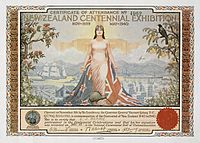 | Popular in the late 19th and early 20th century. Now rarely used, other than as a supporter on the coat of arms. [12] |
Icons of New Zealand culture are almost as well known by New Zealanders and visitors as unofficial symbols. Certain items of popular culture thought to be unique to New Zealand are also called "Kiwiana". [13]
| Image | Remarks | |
|---|---|---|
| The All Blacks |  | The country's national rugby union team – three times world champions, and the country's best known sports team both locally and internationally. |
| The Beehive |  | The distinctly shaped executive wing of New Zealand Parliament Buildings, built in the 1970s. |
| Bungy jumping |  | Popularised by A.J. Hackett in the South Island, [14] it has become a popular extreme sport worldwide. |
| Haka | 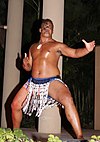 | A traditional Māori war dance, now widely used by sports teams as a challenge and by schools as a tribute or honour. |
| Hei-tiki |  | Traditional Māori ornamental pendants. |
| Kiwifruit |  | This fruit was branded kiwifruit when growers in New Zealand established successful cultivars suitable for export. [15] It remains a major export for the country. |
| Koru | The koru, widely used in traditional Māori art, is a stylised depiction of an unfurling silver fern frond. [16] | |
| The Lord of the Rings |  | The film trilogy (and the subsequent The Hobbit trilogy) highlighted New Zealand's natural scenery and is widely associated with the country worldwide. [17] |
| Mitre Peak |  | A distinctive peak which dominates Milford Sound, one of the country's most popular tourist destinations. [18] |
| Pāua |  | A species of abalone. Its flesh is a delicacy, and its iridescent shell is used for ornamentation. |
| Pavlova |  | A meringue cake with a crisp crust and soft, marshmallow centre, topped with whipped cream and fruit. Its country of origin is widely contested by Australia. [19] |
| Pounamu ("Greenstone") |  | Nephrite jade, highly valued by Māori both physically and spiritually. [20] |
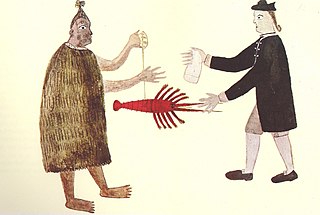
The human history of New Zealand can be dated back to between 1320 and 1350 CE, when the main settlement period started, after it was discovered and settled by Polynesians, who developed a distinct Māori culture. Like other Pacific cultures, Māori society was centred on kinship links and connection with the land but, unlike them, it was adapted to a cool, temperate environment rather than a warm, tropical one. The first European explorer known to have visited New Zealand was the Dutch navigator Abel Tasman, on 13 December 1642. In 1643 he charted the west coast of the North Island, his expedition then sailed back to Batavia without setting foot on New Zealand soil. British explorer James Cook, who reached New Zealand in October 1769 on the first of his three voyages, was the first European to circumnavigate and map New Zealand. From the late 18th century, the country was regularly visited by explorers and other sailors, missionaries, traders and adventurers.

The culture of New Zealand is a synthesis of indigenous Māori, colonial British, and other cultural influences. The country's earliest inhabitants brought with them customs and language from Polynesia, and during the centuries of isolation, developed their own Māori and Moriori cultures. British colonists in the 19th century brought Western culture and had a dramatic effect on the indigenous inhabitants, spreading Western religious traditions and the English language. Over time, a distinct Pākehā or New Zealand European culture emerged.
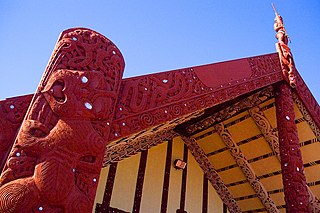
Māori culture is the customs, cultural practices, and beliefs of the indigenous Māori people of New Zealand. It originated from, and is still part of, Eastern Polynesian culture. Māori culture forms a distinctive part of New Zealand culture and, due to a large diaspora and the incorporation of Māori motifs into popular culture, it is found throughout the world. Within Māoridom, and to a lesser extent throughout New Zealand as a whole, the word Māoritanga is often used as an approximate synonym for Māori culture, the Māori-language suffix -tanga being roughly equivalent to the qualitative noun-ending -ness in English. Māoritanga has also been translated as "[a] Māori way of life." The term kaupapa, meaning the guiding beliefs and principles which act as a base or foundation for behaviour, is also widely used to refer to Māori cultural values.

Tino rangatiratanga is a Māori language term that translates literally to 'highest chieftainship' or 'unqualified chieftainship', but is also translated as "self-determination", "sovereignty" and "absolute sovereignty". The very translation of tino rangatiratanga is important to New Zealand politics, as it is used in the Māori version of the Treaty of Waitangi to express "full exclusive and undisturbed possession" over Māori-owned lands and property, but different translations have drastically different implications for the relationship between the 1840 signatories: the British Crown and the Māori chiefs (rangatira).

The flag of New Zealand, also known as the New Zealand Ensign, is based on the British maritime Blue Ensign – a blue field with the Union Jack in the canton or upper hoist corner – augmented or defaced with four red stars centred within four white stars, representing the Southern Cross constellation.

"Kiwi" is a common self-reference used by New Zealanders, though it is also used internationally. Unlike many demographic labels, its usage is not considered offensive; rather, it is generally viewed as a symbol of pride and affection for most people of New Zealand.

Kiwiana are certain items and icons from New Zealand's heritage, especially from around the middle of the 20th century, that are seen as representing iconic New Zealand elements. These "quirky things that contribute to a sense of nationhood" include both genuine cultural icons and kitsch.

Alsophila tricolor, synonym Cyathea dealbata, commonly known as the silver fern or silver tree-fern, or as ponga or punga, is a species of medium-sized tree fern, endemic to New Zealand. The fern is usually recognisable by the silver-white colour of the under-surface of mature fronds. It is a symbol commonly associated with the country both overseas and by New Zealanders themselves.

New Zealanders, colloquially known as Kiwis, are people associated with New Zealand, sharing a common history, culture, and language. People of various ethnicities and national origins are citizens of New Zealand, governed by its nationality law.

The coat of arms of New Zealand is the heraldic symbol representing the South Pacific island country of New Zealand. Its design reflects New Zealand's history as a bicultural nation, with a European female figure on one side and a Māori rangatira (chief) on the other. The symbols on the central shield represent New Zealand's trade, agriculture and industry, and a Crown represents New Zealand's status as a constitutional monarchy.
New Zealanders of European descent are mostly of British and Irish ancestry, with significantly smaller percentages of other European ancestries such as Germans, Poles, French, Dutch, Croats and other South Slavs, Greeks, and Scandinavians. European New Zealanders are also known by the Māori-language loanword Pākehā.

Te Ara: The Encyclopedia of New Zealand is an online encyclopedia established in 2001 by the New Zealand Government's Ministry for Culture and Heritage. The web-based content was developed in stages over the next several years; the first sections were published in 2005, and the last in 2014 marking its completion. Te Ara means "the pathway" in the Māori language, and contains over three million words in articles from over 450 authors. Over 30,000 images and video clips are included from thousands of contributors.

New Zealand is an island country in the southwestern Pacific Ocean. It consists of two main landmasses—the North Island and the South Island —and over 700 smaller islands. It is the sixth-largest island country by area and lies east of Australia across the Tasman Sea and south of the islands of New Caledonia, Fiji, and Tonga. The country's varied topography and sharp mountain peaks, including the Southern Alps, owe much to tectonic uplift and volcanic eruptions. New Zealand's capital city is Wellington, and its most populous city is Auckland.

An Encyclopaedia of New Zealand is an official encyclopaedia about New Zealand, published in three volumes by the New Zealand Government in 1966. Edited by Alexander Hare McLintock, the parliamentary historian, assisted by two others, the encyclopaedia included over 1,800 articles and 900 biographies, written by 359 contributing authors.
The following lists events that happened during 1821 in New Zealand.

The Ministry for Culture and Heritage is the department of the New Zealand Government responsible for supporting the arts, culture, built heritage, sport and recreation, and broadcasting sectors in New Zealand and advising government on such.

Arnold Manaaki Wilson was a New Zealand artist and educator of Māori descent. He is regarded as a pioneer of the modern Māori art movement.
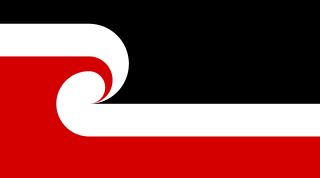
The national Māori flag, also known as the Tino Rangatiratanga flag in reference to the concept of tino rangatiratanga, is used to represent the Māori people of New Zealand. In 2009, the Tino Rangatiratanga flag was selected as the national Māori flag after a nationwide consultation. It was first revealed on Waitangi Day in 1990. Though it does not have official status from the New Zealand Government, it has been used by the government on official occasions.
The Third Fox Ministry was a responsible government which held power in New Zealand from June 1869 to September 1872. Although William Fox was the head of the government, he was never appointed Premier as that office had yet to be established, although he did resign the office at the end of his tenure. The Ministry was also known as the Fox-Vogel Ministry as most of the agenda was set by the Treasurer, while Fox busied himself with administrative affairs and moral crusades such as the attempted introduction of local option polls for liquor licensing.
The Waterhouse Ministry was a responsible government which held power in New Zealand from October 1872 to March 1873, led by the Hon. George Waterhouse from the Legislative Council. It is notable as the first Ministry to include Māori as members of Cabinet.